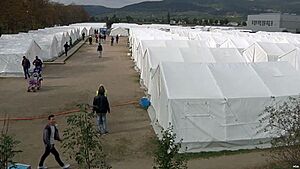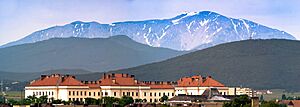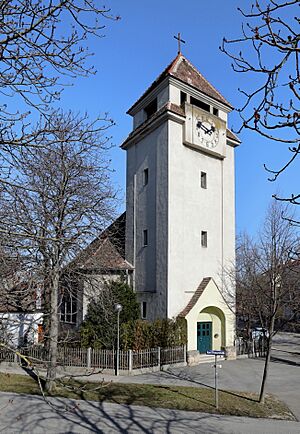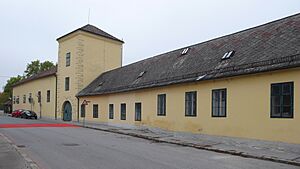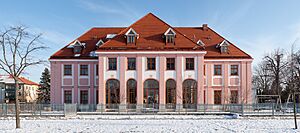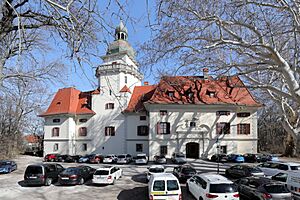Traiskirchen facts for kids
Quick facts for kids
Traiskirchen
|
||
|---|---|---|
|
Municipality
|
||
|
||
| Country | Austria | |
| State | Lower Austria | |
| District | Baden | |
| Area | ||
| • Total | 29.1 km2 (11.2 sq mi) | |
| Elevation | 200 m (700 ft) | |
| Time zone | UTC+1 (CET) | |
| • Summer (DST) | UTC+2 (CEST) | |
| Postal code |
2514
|
|
| Area code | 02252 | |
| Website | www.traiskirchen.gv.at | |
Traiskirchen is a city and municipality in the Baden district of Lower Austria, Austria. It's about 20 kilometers (12 miles) south of Vienna. This area, called the Thermenlinie, is famous for its delicious wine and traditional heuriger restaurants. Traiskirchen is also home to the Traiskirchen Lions basketball team and has the oldest public astronomical observatory in Lower Austria. The city is also known for its special center that helps people seeking safety and a new home.
Contents
Parts of Traiskirchen
The municipality of Traiskirchen is made up of five smaller towns. Here's how many people lived in each as of February 28, 2023:
- Traiskirchen (7,777 people)
- Möllersdorf (5,177 people)
- Wienersdorf (3,427 people)
- Tribuswinkel (4,295 people)
- Oeynhausen (1,413 people)
Population Growth
The numbers below show the total population for the entire municipality of Traiskirchen, not just the main city. You can see how the population has grown over many years.
| Historical population | ||
|---|---|---|
| Year | Pop. | ±% |
| 1869 | 3,909 | — |
| 1880 | 4,380 | +12.0% |
| 1890 | 4,947 | +12.9% |
| 1900 | 6,011 | +21.5% |
| 1910 | 8,436 | +40.3% |
| 1923 | 8,139 | −3.5% |
| 1934 | 8,922 | +9.6% |
| 1939 | 8,908 | −0.2% |
| 1951 | 8,057 | −9.6% |
| 1961 | 9,247 | +14.8% |
| 1971 | 11,978 | +29.5% |
| 1981 | 14,063 | +17.4% |
| 1991 | 13,952 | −0.8% |
| 2001 | 15,669 | +12.3% |
| 2011 | 17,169 | +9.6% |
| 2023 | 21,440 | +24.9% |
Refugee Welcome Center
Traiskirchen is home to Austria's largest center for people seeking refuge, and it's one of the biggest in the European Union. This center is located in the middle of Traiskirchen, in buildings that were once a military school built in 1900. The school used to house hundreds of students and staff.
After World War II, from 1945 to 1955, the buildings were used by the Soviet army. Then, from 1956 to 1960, the Austrian government started using them as a refugee center.
The first large group of people to stay there were Hungarian refugees in 1956, who had to leave their homes because of the Hungarian Revolution. Thousands of people came to Austria, and many found shelter in Traiskirchen. After this, it was decided that the center would continue to help people from all over the world.
Over the years, the center has welcomed people from many different countries, including those from Czechoslovakia after the Prague Spring in 1968, and later from Eastern Europe, Uganda, Chile, Iran, Iraq, and Vietnam. Many famous people who later became important figures, like opera director Ioan Holender and journalist Paul Lendvai, first stayed here.
In 1993, the center was officially renamed the "Asylum Office of the Federal Ministry of the Interior," which means it's managed by the government to help people seeking asylum. In 2015, during a time when many people were seeking safety in Europe, the center helped a very large number of individuals.
Education in Traiskirchen
Traiskirchen has many schools and educational places for children and young adults.
Kindergarten
Younger children can attend one of these kindergartens:
- Kindergarten Möllersdorf Pestalozzi-Gasse
- Kindergarten Möllesdorf Schlössl
- Kindergarten Traiskirchen Bärenhöhle
- Kindergarten Traiskirchen Biberburg
- Kindergarten Traiskirchen Alfons Petzold
- Kindergarten Tribuswinkel Schloss
- Kindergarten Tribuswinkel Badner Straße
- Kindergarten Wienersdorf
- Oeynhausen Pfarrkindergarten (a church kindergarten)
Schools
Primary Schools
Children attend primary school (Volksschule) in:
- Volksschule Möllersdorf
- Volksschule Tribuswinkel
- Volksschule Traiskirchen
For safety, the primary school in Traiskirchen has a fence around it.
Secondary School
- Sport Middleschool Traiskirchen is a secondary school that focuses on sports.
School for Students with Special Needs
- Sonderschule Traiskirchen is a special school for pupils who need extra support.
Police Training School
The "Bildungszentrum der Sicherheitsexekutive (BZS)" Traiskirchen is a special school where people train to become police officers in Austria.
School Diversity
The schools in Traiskirchen are known for having a very diverse group of students from many different backgrounds. This mix of cultures and languages is often talked about. Traiskirchen does not have a high school or a university for higher education.
Cool Places to See
Traiskirchen has several interesting sights to visit.
Franz-Koller Observatory
This observatory is the oldest in the state of Lower Austria and has been open to the public since 1967. It's special because it's right in the middle of the city.
St. Nicholas Church
This church is very old, built around the year 1400.
St. Margaret Church
This church was rebuilt in 1683 after the siege of Vienna. It was built on its original gothic foundations.
Lutheran Church
This church was built in 1913.
The Geldscheisser
The famous "Geldscheisser" is a unique statue located in the city center.
Malt Factory
This old malt factory was once owned by a famous banker named Max Mauthner.
Castle of Moellersdorf
This castle was built around 1690–1700. Later, around 1780, Emperor Joseph II turned it into a military barracks.
Castle of Tribuswinkel
This castle is very old, possibly founded as early as 1120 or 1136. It was likely built as a water castle, surrounded by water, but the old walls and moat are no longer there.
Basketball in Traiskirchen
Traiskirchen is a big name in Austrian basketball! It's home to the Traiskirchen Lions, who have won the Österreichische Basketball Bundesliga championship three times. The team plays their home games in a special arena called the Lions Dome.
Famous People from Traiskirchen
Many interesting people have connections to Traiskirchen:
- Joseph Fendi, who was the father of the famous painter Peter Fendi.
- Hans Seischab (1898-1965), a professor who taught about business.
- Hellmuth Swietelsky (1905-1995), a businessman who started a big construction company.
- Franz Kroller (1923-2000), who was the director of the University Library in Graz.
- Otto Vogl (1927-2013), a well-known chemist.
- Harald Neudorfer (born 1962), a professor who studies propulsion technology (how things move forward, like rockets).
See also
 In Spanish: Traiskirchen para niños
In Spanish: Traiskirchen para niños




